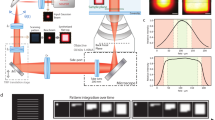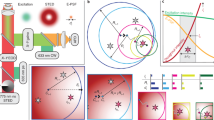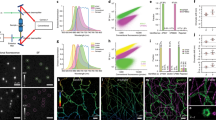Abstract
Fluorescence photoactivation localization microscopy (FPALM) images biological structures with subdiffraction-limited resolution. With repeated cycles of activation, readout and bleaching, large numbers of photoactivatable probes can be precisely localized to obtain a map (image) of labeled molecules with an effective resolution of tens of nanometers. FPALM has been applied to a variety of biological imaging applications, including membrane, cytoskeletal and cytosolic proteins in fixed and living cells. Molecular motions can be quantified. FPALM can also be applied to nonbiological samples, which can be labeled with photoactivatable probes. With emphasis on cellular imaging, we describe here the adaptation of a conventional widefield fluorescence microscope for FPALM and present step-by-step procedures to successfully obtain and analyze FPALM images. The fundamentals of this protocol may also be applicable to users of similar imaging techniques that apply localization of photoactivatable probes to achieve super-resolution. Once alignment of the setup has been completed, data acquisitions can be obtained in approximately 1–30 min and analyzed in approximately 0.5–4 h.
This is a preview of subscription content, access via your institution
Access options
Subscribe to this journal
Receive 12 print issues and online access
$259.00 per year
only $21.58 per issue
Buy this article
- Purchase on Springer Link
- Instant access to full article PDF
Prices may be subject to local taxes which are calculated during checkout






Similar content being viewed by others
References
Born, M. & Wolf, E. Principles of Optics: Electromagnetic Theory of Propagation, Interference and Diffraction of Light (Cambridge University Press, New York, 1997).
Hell, S.W. Far-field optical nanoscopy. Science 316, 1153–1158 (2007).
Hell, S.W. & Wichmann, J. Breaking the diffraction resolution limit by stimulated emission: stimulated-emission-depletion fluorescence microscopy. Opt. Lett. 19, 780–782 (1994).
Hess, S.T., Girirajan, T.P. & Mason, M.D. Ultra-high resolution imaging by fluorescence photoactivation localization microscopy (FPALM). Biophys. J. 91, 4258–4272 (2006).
Betzig, E. et al. Imaging intracellular fluorescent proteins at nanometer resolution. Science 313, 1642–1645 (2006).
Rust, M.J., Bates, M. & Zhuang, X. Sub-diffraction-limit imaging by stochastic optical reconstruction microscopy (STORM). Nat. Methods 3, 793–796 (2006).
Hess, S.T. et al. Dynamic clustered distribution of hemagglutinin resolved at 40 nm in living cell membranes discriminates between raft theories. Proc. Natl. Acad. Sci. USA 104, 17370–17375 (2007).
Geisler, C. et al. Resolution of λ/10 in fluorescence microscopy using fast single molecule photo-switching. Appl. Phys. A 88, 223–226 (2007).
Flors, C. et al. A stroboscopic approach for fast photoactivation-localization microscopy with dronpa mutants. J. Am. Chem. Soc. 129, 13970–13977 (2007).
Manley, S. et al. High-density mapping of single-molecule trajectories with photoactivated localization microscopy. Nat. Methods 5, 155–157 (2008).
Shroff, H., Galbraith, C.G., Galbraith, J.A. & Betzig, E. Live-cell photoactivated localization microscopy of nanoscale adhesion dynamics. Nat. Methods 5, 417–423 (2008).
Bates, M., Huang, B., Dempsey, G.T. & Zhuang, X. Multicolor super-resolution imaging with photo-switchable fluorescent probes. Science 317, 1749–1753 (2007).
Shroff, H. et al. Dual-color superresolution imaging of genetically expressed probes within individual adhesion complexes. Proc. Natl. Acad. Sci. USA 104, 20308–20313 (2007).
Bock, H. et al. Two-color far-field fluorescence nanoscopy based on photo-switchable emitters. Appl. Phys. B 88, 161–165 (2007).
Huang, B., Wang, W., Bates, M. & Zhuang, X. Three-dimensional super-resolution imaging by stochastic optical reconstruction microscopy. Science 319, 810–813 (2008).
Juette, M.F. et al. Three-dimensional sub-100 nm resolution fluorescence microscopy of thick samples. Nat. Methods 5, 527–529 (2008).
Huang, B., Jones, S.A., Brandenburg, B. & Zhuang, X. Whole-cell 3D STORM reveals interactions between cellular structures with nanometer-scale resolution. Nat. Methods 5, 1047–1052 (2008).
Gould, T.J. et al. Nanoscale imaging of molecular positions and anisotropies. Nat. Methods 5, 1027–1030 (2008).
Bates, M., Blosser, T.R. & Zhuang, X. Short-range spectroscopic ruler based on a single-molecule optical switch. Phys. Rev. Lett. 94, 108101 (2005).
Lukyanov, K.A., Chudakov, D.M., Lukyanov, S. & Verkhusha, V.V. Innovation: photoactivatable fluorescent proteins. Nat. Rev. Mol. Cell Biol. 6, 885–891 (2005).
Patterson, G.H. & Lippincott-Schwartz, J. A photoactivatable GFP for selective photolabeling of proteins and cells. Science 297, 1873–1877 (2002).
Chudakov, D.M. et al. Photoswitchable cyan fluorescent protein for protein tracking. Nat. Biotechnol. 22, 1435–1439 (2004).
Verkhusha, V.V. & Sorkin, A. Conversion of the monomeric red fluorescent protein into a photoactivatable probe. Chem. Biol. 12, 279–85 (2005).
Subach, F.V. et al. Photoactivatable mCherry for high-resolution two-color fluorescence microscopy. Nat. Methods (in press).
van Thor, J.J., Gensch, T., Hellingwerf, K.J. & Johnson, L.N. Phototransformation of green fluorescent protein with UV and visible light leads to decarboxylation of glutamate 222. Nat. Struct. Biol. 9, 37–41 (2002).
Tsien, R.Y. The green fluorescent protein. Annu. Rev. Biochem. 67, 509–544 (1998).
Ando, R., Hama, H., Yamamoto-Hino, M., Mizuno, H. & Miyawaki, A. An optical marker based on the UV-induced green-to-red photoconversion of a fluorescent protein. Proc. Natl. Acad. Sci. USA 99, 12651–12656 (2002).
Wiedenmann, J. et al. EosFP, a fluorescent marker protein with UV-inducible green-to-red fluorescence conversion. Proc. Natl. Acad. Sci. USA 101, 15905–15910 (2004).
Tsutsui, H., Karasawa, S., Shimizu, H., Nukina, N. & Miyawaki, A. Semi-rational engineering of a coral fluorescent protein into an efficient highlighter. EMBO Rep. 6, 233–238 (2005).
Gurskaya, N.G. et al. Engineering of a monomeric green-to-red photoactivatable fluorescent protein induced by blue light. Nat. Biotechnol. 24, 461–465 (2006).
Chudakov, D.M., Lukyanov, S. & Lukyanov, K.A. Tracking intracellular protein movements using photoswitchable fluorescent proteins PS-CFP2 and dendra2. Nat. Protoc. 2, 2024–2032 (2007).
Chudakov, D.M. et al. Kindling fluorescent proteins for precise in vivo photolabeling. Nat. Biotechnol. 21, 191–194 (2003).
Ando, R., Mizuno, H. & Miyawaki, A. Regulated fast nucleocytoplasmic shuttling observed by reversible protein highlighting. Science 306, 1370–1373 (2004).
Stiel, A.C. et al. 1.8 a bright-state structure of the reversibly switchable fluorescent protein dronpa guides the generation of fast switching variants. Biochem. J. 402, 35–42 (2007).
Ando, R., Flors, C., Mizuno, H., Hofkens, J. & Miyawaki, A. Highlighted generation of fluorescence signals using simultaneous two-color irradiation on dronpa mutants. Biophys. J. 92, L97–L99 (2007).
Zacharias, D.A., Violin, J.D., Newton, A.C. & Tsien, R.Y. Partitioning of lipid-modified monomeric GFPs into membrane microdomains of live cells. Science 296, 913–916 (2002).
Egner, A. et al. Fluorescence nanoscopy in whole cells by asynchronous localization of photoswitching emitters. Biophys. J. 93, 3285–3290 (2007).
Haupts, U., Maiti, S., Schwille, P. & Webb, W.W. Dynamics of fluorescence fluctuations in green fluorescent protein observed by fluorescence correlation spectroscopy. Proc. Natl. Acad. Sci. USA 95, 13573–13578 (1998).
Schwille, P., Kummer, S., Heikal, A.A., Moerner, W.E. & Webb, W.W. Fluorescence correlation spectroscopy reveals fast optical excitation-driven intramolecular dynamics of yellow fluorescent proteins. Proc. Natl. Acad. Sci. USA 97, 151–156 (2000).
Heikal, A.A., Hess, S.T., Baird, G.S., Tsien, R.Y. & Webb, W.W. Molecular spectroscopy and dynamics of intrinsically fluorescent proteins: Coral red (dsred) and yellow (citrine). Proc. Natl. Acad. Sci. USA 97, 11996–12001 (2000).
Dickson, R.M., Cubitt, A.B., Tsien, R.Y. & Moerner, W.E. On/off blinking and switching behaviour of single molecules of green fluorescent protein. Nature 388, 355–358 (1997).
Enderlein, J., Toprak, E. & Selvin, P.R. Polarization effect on position accuracy of fluorophore localization. Opt. Expr. 14, 8111–8120 (2006).
Thompson, R.E., Larson, D.R. & Webb, W.W. Precise nanometer localization analysis for individual fluorescent probes. Biophys. J. 82, 2775–2783 (2002).
Shaner, N.C., Patterson, G.H. & Davidson, M.W. Advances in fluorescent protein technology. J. Cell Sci. 120, 4247–4260 (2007).
Ha, T. Single-molecule fluorescence resonance energy transfer. Methods 25, 78–86 (2001).
Hess, S.T., Gould, T.J., Gunewardene, M., Bewersdorf, J. & Mason, M.D. Ultra-high resolution imaging of biomolecules by fluorescence photoactivation localization microscopy (FPALM). In Methods in Molecular Biology (eds. Foote, R.S. & Lee, J.W.) in press (Humana Press, Totowa, NJ).
Self, S.A. Focusing of spherical Gaussian beams. Appl. Opt. 22, 658 (1983).
Currie, L.A. Limits for qualitative detection and quantitative determination. Anal. Chem. 40, 586–593 (1968).
Gordon, M.P., Ha, T. & Selvin, P.R. Single-molecule high-resolution imaging with photobleaching. Proc. Natl. Acad. Sci. USA 101, 6462–6465 (2004).
Qu, X., Wu, D., Mets, L. & Scherer, N.F. Nanometer-localized multiple single-molecule fluorescence microscopy. Proc. Natl. Acad. Sci. USA 101, 11298–11303 (2004).
Cheezum, M.K., Walker, W.F. & Guilford, W.H. Quantitative comparison of algorithms for tracking single fluorescent particles. Biophys. J. 81, 2378–2388 (2001).
Pawley, J.B. Handbook of Biological Confocal Microscopy (Plenum Press, New York, 1995).
Ripley, B.D. Tests of randomness for spatial point patterns. J. R. Stat. Soc. Ser. B 41, 368–374 (1979).
Pathria, R.K. Statistical Mechanics (Butterworth-Heinemann, Oxford, Boston, 1996).
Lakowicz, J.R. Principles of Fluorescence Spectroscopy (Springer Science, New York, 2006).
Sternberg, S.R. Biomedical image processing. IEEE Comput. 16, 22–34 (1983).
Acknowledgements
We thank Christopher Fang-Yen, Paul Blank, Joerg Bewersdorf, Joshua Zimmerberg, George Patterson, Julie Gosse and Michael Mason for useful discussions, Paul Millard and Carol Kim for use of equipment and reagents, Ed Allgeyer, Manasa Gudheti and Siyath Gunewardene for laboratory assistance, Matthew Parent for programming assistance and Thomas Tripp, Tony McGinn and Kyle Jensen for machining services. This work was supported by grants K25-AI-65459 from the National Institute of Allergy and Infectious Diseases (S.T.H.), CHE-0722759 from the National Science Foundation (S.T.H.), start-up funds from the University of Maine (S.T.H.) and by grants GM070358 and GM073913 from the National Institute of General Medical Sciences (V.V.V.).
Author information
Authors and Affiliations
Corresponding author
Rights and permissions
About this article
Cite this article
Gould, T., Verkhusha, V. & Hess, S. Imaging biological structures with fluorescence photoactivation localization microscopy. Nat Protoc 4, 291–308 (2009). https://doi.org/10.1038/nprot.2008.246
Published:
Issue Date:
DOI: https://doi.org/10.1038/nprot.2008.246
This article is cited by
-
Scanning single molecule localization microscopy (scanSMLM) for super-resolution volume imaging
Communications Biology (2023)
-
Discrimination of normal and cancerous human skin tissues based on laser-induced spectral shift fluorescence microscopy
Scientific Reports (2022)
-
A coordinate-based co-localization index to quantify and visualize spatial associations in single-molecule localization microscopy
Scientific Reports (2022)
-
Constructing a cost-efficient, high-throughput and high-quality single-molecule localization microscope for super-resolution imaging
Nature Protocols (2022)
-
Low-power STED nanoscopy based on temporal and spatial modulation
Nano Research (2022)
Comments
By submitting a comment you agree to abide by our Terms and Community Guidelines. If you find something abusive or that does not comply with our terms or guidelines please flag it as inappropriate.



